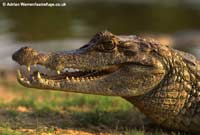
Trinidad and Tobago has some of the richest natural communities in the Caribbean. Unlike most of the islands of the Caribbean, Trinidad and Tobago supports a primarily South American flora and fauna. As a result, Trinidad and Tobago is richer in plant and animal species than is the rest of the Caribbean. However, rates of endemism are lower than in the rest of the Caribbean because most of the species in Trinidad and Tobago are also found on the South American mainland.1
Also known as the spectacled caiman, the common caiman has a bony ridge and slightly lighter color around each eye. Its body is greenish to brownish gray, sometimes with noticeable dark bands on its tail and patches on its back. It may grow up to about 8 feet (2.4m). Male are also larger than females. It shares its habitat in the Nariva Swamp on Trinidad's east coast with the mighty Green Anaconda (Eunectes murinus). Caiman are to be found throughout both islands in slow moving fresh or brackish water. The are shy creatures and pose no real threat to humans unless intentionally provoked or approached while nesting. While it was considered that the few records of both the American Crocodile (Crocodylus acutus) as well as the Orinoco Crocodile (Crocodylus intermedius) in the waters of Trinidad and Tobago were, for the most part, waifs from mainland South America, there are many reports of both of these species from the Caroni Swamp area and throughout the Caroni basin, some individuals growing up to 15 ft (4.6 m) in length.2 Maximum longevity is around 24.1 years.3
Taxonomically, the Spectacled Caiman is classified as follows:
Kingdom: Animalia
Phylum: Chordata
Class: Reptilia
Order: Crocodilia
Family: Alligatoridae
Genus: Caiman
Species: Caiman crocodilus